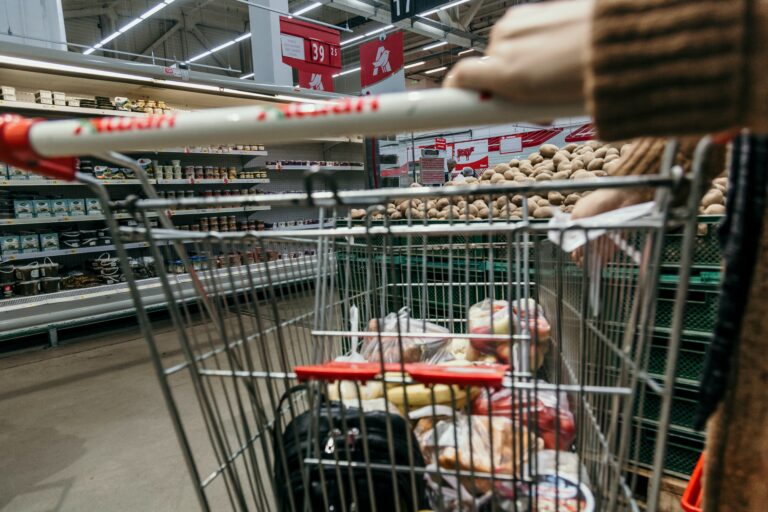Food and Nutrition Education Resources
Navigating the Grocery Store on a Budget
By: Jaz Popa, 2/3/2023

Grocery stores are designed to make you spend money, meticulously planned from the music down to the aisle placements. And with the high cost of food, grocery shopping on a budget is harder than ever. However, with these tips, you will be sure to stretch your food dollars as far as possible.
1. Have a Plan
Before heading to the grocery store, having a plan is key. Start by browsing sale flyers for your local grocery stores and checking what produce is in season in your area at that time. In–season produce is often on sale, so shopping in season is a great way to save money. Click here to learn what’s in season. Use the sale flyers and in-season produce to plan your meals for your grocery shopping trip.
Once you’ve checked out the cheapest items to purchase, plan your meals. Keep in mind how busy you are that week, and how often you plan to be cooking versus ordering out. List out the ingredients for each recipe and check your pantry. Be sure to cross off what you already have so you aren’t spending money buying things you don’t need.
Once you know what you need, and don’t need, for your shopping trip, make your list. Organize your list by food category, i.e., produce, dairy, canned goods, etc. This will prevent you from going back to the same section of the store multiple times, saving you time but also preventing you from browsing more aisles and potentially grabbing things you don’t really need because the longer you’re in the store, the more money you’ll spend!
2. Know Your Stores Layout
Grocery stores are laid out in a specific way to get you to stay there longer, buy more food, and spend more money. By knowing its layout, you can avoid this.
No matter where you’re shopping, start with the perimeter. This is where all the perishable items, like produce, meat, and dairy, are located. These are usually more expensive, more essential items, and shopping them first leaves less space in your cart for non-essentials. After you shop the perimeter, head down the aisles that you have on your list. Avoid walking down every aisle to prevent impulse buys.
Produce that is separated from the rest of the produce or at the very front of the store is often in season and/or on sale. This is a great place to check for the cheapest and tastiest produce available.
Grocery stores will place the most expensive items at eye level. So, be sure to look around to find the cheapest items available (often store-brand). If you have a child shopping with you, remember that kid-targeted food will be placed at THEIR eye level. Keeping their attention focused elsewhere or their eyesight a little higher will help avoid any tantrum-induced impulse purchases.
3. Time to Shop
Many grocery stores now have apps available that can make grocery shopping faster and more convenient. You can use the apps to look for sales, find where items are located in the store, make a list, and much more. It’s also worth grabbing a flyer when you get to the store. You can check to see if there are any day-of-sales or extra coupons. Signing up for store rewards and emails is another great way to save money. You will often get extra coupons and information on sales.
When you’re shopping, it might always seem cheaper to buy in bulk. This is a great way to save money when you’re buying non-perishable items, however, not always the best choice when purchasing perishable food. If you’re shopping for one person and see that the extra–large bag of carrots is $5, but the small bag of carrots is $4, you might think, “wow, the big bag is a better deal,” and purchase the big bag. But if you don’t eat carrots very often, that extra–large bag of carrots will probably sit in the back of your fridge until they’re rotten and get thrown away. Throwing away food is like throwing money straight into the trash. Although that big bag of carrots might have been cheaper per pound, it wasn’t cheaper for you. So, be mindful of how many people you are shopping for so you aren’t wasting food and ultimately wasting money.
When you’re shopping and see a sale or coupon, it’s easy to justify the purchase. Unless it is already on your list, leave that item for someone else. You probably don’t need the item, so it will likely end up going to waste anyway.
We’ve all been to the grocery store, spent way more than our budget, and then looked in the fridge just to think, “I have nothing to eat,” all because we went shopping on an empty stomach. You’ve heard it once, and you’ll hear it again, don’t go to the grocery store on an empty stomach! If you happen to get to the store and realize how hungry you are, don’t be afraid to snack on those grapes or protein bars you are already buying.
